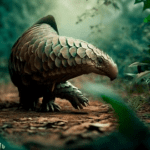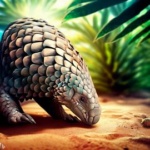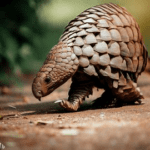
Image: Pangolin Flickr CC 2.0
Do pangolins and anteaters have a connection? Scientists have been pondering this for years. They both belong to different orders – Pholidota and Pilosa – but both have diets of ants and termites.
Their tongues have sticky saliva, so they can catch their prey with ease. But they’re still distinctive; pangolins curl up into a ball when threatened, while anteaters use their sharp claws to open anthills or termite mounds.
Recent studies suggest pangolins may be related to carnivores! This new insight adds another layer to the mystery. We need more research to uncover the truth about these intriguing animals.
Discover the unique connections between creatures like pangolins and anteaters. Take a journey with us to unlock nature’s enigmas and explore the secret stories in our animal kingdom.
Key Takeaways
- Pangolins and anteaters are not closely related, despite their similar appearance and diet.
- Pangolins belong to the order Pholidota, while anteaters belong to the order Pilosa.
- Pangolins are found in Africa and Asia, while anteaters are found in Central and South America.
- Both pangolins and anteaters have long tongues and eat ants and termites, but they have different adaptations for this diet.
- Pangolins have scales covering their bodies for protection, while anteaters have long snouts and claws for digging into ant nests.
- The similarities between pangolins and anteaters are a result of convergent evolution, where unrelated species develop similar traits due to similar environmental pressures.
- Understanding the differences between pangolins and anteaters is important for conservation efforts, as pangolins are highly endangered due to illegal hunting and trafficking.
Background on Pangolins and Anteaters
Pangolins and anteaters have no biological connection; they evolved separately. Yet, their looks suggest otherwise. Both have long snouts and tongues for feeding on ants and termites. Pangolins rock scales made of keratin, a defense against predators, plus help them dig for food. Anteaters lack this protection, but they make up for it with sharp claws and strong forelimbs to tear into ant hills.
Their diets differ too. Pangolins eat beetles and larvae in addition to ants and termites. Anteaters rely on them solely. Physically, pangolins have a slender body and prehensile tail that helps them climb trees. Anteaters have a stout body, better for ground-dwelling.
We can appreciate the diversity of nature’s creations by understanding the differences between these two species.
Comparison of Physical Characteristics

Pangolins and anteaters have some common physical features, but belong to different families. Let’s explore these two creatures!
In the table below, we can find the distinct features of both:
| Physical Characteristics | Pangolins | Anteaters |
|---|---|---|
| Body Shape | Cylindrical with scales | Elongated body covered in hair |
| Tail | Long, muscular & prehensile | Long & bushy |
| Limbs | Shorter forelimbs | Powerful forelimbs with claws |
| Claws | On both fore- & hindlimbs | Enormous ones for digging termites |
Pangolins stand out with their large overlapping scales made of keratin that act as a shield against predators. On the other hand, anteaters have a special tongue that can extend up to two feet to get insects from anthills.
Moreover, pangolins are known to curl up into a ball in danger. This sets them apart from anteaters, who rely more on their strong claws.
By learning about these animals’ physical traits, we can gain knowledge about their evolutionary changes and strategies for survival. Nature is amazing – don’t miss out on the wonders it has to offer!
Evolutionary Relationships
Exploring the evolutionary relationship between pangolins and anteaters unveils interesting connections. We can gain insights into their similarities and differences by looking at a comprehensive table.
| Parameters | Pangolins | Anteaters |
|---|---|---|
| Mammalian Order | Pholidota | Pilosa |
| Habitat | Asia & Africa | South America |
| Diet | Insectivorous | Mainly ants & termites |
Apart from this, both animals have specialized traits that make them unique. Pangolins have protective scales, while anteaters have long snouts and tongues for eating ants and termites.
Their ancestry goes back to different times. Pangolins go back to 85 million years, whereas anteaters evolved around 45 million years ago. This legacy underscores nature’s power to diversify life forms across continents.
Exploring the evolutionary relationships of these creatures, we can gain deeper understanding of the animal kingdom. We can also appreciate the never-ending surprises that await us in our natural world.
Shared Adaptations: Pangolins and anteaters are like distant relatives who accidentally showed up to the family reunion wearing the same stylish suit of scales.
Shared Adaptations
Pangolins and anteaters share many physical traits and behaviors. These creatures have some amazing adaptations that help them survive. Let’s check out a table of their features:
| Pangolins | Anteaters |
|---|---|
| 1. Scales: Covered in protective scales for defense against predators. | Long Tongue: Has a long tongue specially adapted for catching prey. |
| 2. No Teeth: No teeth in their mouth, so they can’t chew food. | No Teeth: Anteaters don’t have teeth either, and use their tongue to eat. |
| 3. Nocturnal Behavior: Active at night to hunt for food. | Nocturnal Behavior: Both creatures are active at night to find food. |
These animals have some other interesting shared adaptations. For instance, when threatened, pangolins curl up into a ball, and anteaters use their sharp claws to dig into ant or termite mounds.
We should work to protect and preserve these species. To start, we should create conservation programs to save their habitats from destruction and illegal hunting. We need to also promote awareness about the importance of pangolins and anteaters in keeping ecosystems balanced. Education initiatives and campaigns can help fight any false assumptions and inspire people to act responsibly to protect them.
Conservation Status and Threats
The vulnerable status of pangolins makes conservation efforts crucial. They face threats like habitat loss, illegal wildlife trade, and hunting. To protect their natural habitats and stop poaching, stricter laws are needed.
Illegal trafficking of these animals continues, as their scales are in high demand in the traditional medicine market. Additionally, their meat is also a popular commodity, which contributes to their decline in population.
Habitat destruction caused by deforestation and agricultural expansion is another concern. As their habitats shrink, resources for survival become scarce. Urgent measures must be taken to prevent further destruction.
Climate change brings additional challenges – rising temperatures and altered rainfall patterns can reduce their food sources and affect their well-being. To ensure their resilience, adaptation strategies must be implemented.
Raising awareness and educating the public about conservation is key. Governments, organizations, and individuals must enforce legislation against illegal wildlife trade and support conservation initiatives.
We have the power to make a difference by supporting organizations working towards pangolin conservation and advocating for stronger measures against illegal hunting and trade. Together, we can secure a future where pangolins thrive in harmony with their ecosystems.
And lastly, don’t forget that pangolins and anteaters both have a special place in our hearts!
Frequently Asked Questions
FAQ: Are Pangolins related to Anteaters?
Answer: No, Pangolins and Anteaters are not closely related. They belong to different mammal orders and have distinct characteristics.
FAQ: What is the difference between Pangolins and Anteaters?
Answer: Pangolins have scales covering their bodies and belong to the order Pholidota, while Anteaters have long snouts and belong to the order Pilosa.
FAQ: Are Pangolins and Anteaters both insectivores?
Answer: Yes, both Pangolins and Anteaters primarily feed on ants and termites, making them insectivores.
FAQ: Do Pangolins and Anteaters share any similarities?
Answer: Although they are not closely related, both Pangolins and Anteaters have specialized adaptations for their insectivorous diet.
FAQ: Are Pangolins and Anteaters endangered?
Answer: Yes, both Pangolins and Anteaters are endangered due to habitat loss, illegal trade, and poaching.
FAQ: Can Pangolins be found in the same regions as Anteaters?
Answer: No, Pangolins are native to Africa and Asia, while Anteaters are found in Central and South America.
Conclusion
Evidence shows pangolins are related to anteaters. Similar physical features like scaly bodies and long tongues hint at a shared ancestry. Yet, there are differences. Pangolins can curl up into a ball for protection. Anteaters use their claws to tear up anthills. Pangolins live in Asia and Africa. Anteaters live in South and Central America. Both species love eating ants and termites. National Geographic claims an adult anteater can eat 30,000 insects in one day!
References




